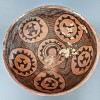
| Culture | Branch | Tradition | Ware | Type |
| Ancestral Pueblo: Southern Colorado Plateau (Anasazi) | Central Anasazi | Southern Cibola | White Mountain Red Ware | St Johns Black-on-red - Polychrome |
Type Name: St Johns Black-on-red - Polychrome |
|
| Period: | 1150 A.D. - 1300 A.D. |
| Culture: | Ancestral Pueblo: Southern Colorado Plateau (Anasazi) |
| Branch: | Central Anasazi |
| Tradition: | Southern Cibola |
| Ware: | White Mountain Red Ware |
First posted by C. Dean Wilson 2012
St. Johns Polychrome was defined by Gladwin and Gladwin (1931). This type developed directly out of Wingate Polychrome, but can usually be distinguished from this type by differences in slip color and designs (Carlson 1970l Hays-Gilpin and van Hartesveldt). While the production of St Johns Polychrome and Black-on-red seems to partly but not completely correspond to areas associated with other White Mountain Red Ware tradition, pottery exhibiting characteristics of this type appears to be more widely distributed than that noted for a range of black-on-red and polychrome types that developed out St Johns Black-on-red (Carlson 1970). The St John types appear to have been produced from about A.D. 1150 to 1300.
Paste is hard, crumbly, and tends to by light brown, gray, or orange color. Temper is dominated by similar colored relatively large sherd fragments and sometimes occasional sand fragments. While some examples exhibit red slips similar to those noted in earlier White Mountain Red Ware types, many have distinct slips that are more of a lighter red, orange and sometimes brownish color. Pigment has been commonly an organic paint or black mineral is sometimes represented but actually represents a range of combinations of copper and lead glaze pigments. The range of combinations of pigments noted appear to ultimately reflect the shift from copper pigments used in the early White Mountain Red Ware types and glaze paint associated with types with both White Mountain Wares produced in the Point of Pines area and glaze ware types produced over much of the Rio Grande region.
Like the Wingate types, designs consist of hatched and solid elements but line work tends to be finer and better executed. Both solid and hatched designs are often organized in bold and repeating scrolls. Hachured elements tend to be more closely spaced. Hatching is sometimes organized longitudinally or horizontally. Designs often resemble those noted for Tularosa Black-on-white. Decorations cover much of the vessel from the rim. Vessels are overwhelmingly represented by bowls although pitchers, ladles, and jars do occur. Rims are commonly flat but may be beveled. St Johns Polychrome is identical to St Johns Polychrome but with exterior designs executed in white clay (Carlson 1970). and jars are almost never assigned to St Johns Polychrome. These decorations usually consist of broad parallel white lines usually organized in continuous chevron, rectilinear or scroll patterns.
References:
Carlson, Roy L.
1970 White Mountain Redware Pottery Tradition of East-Central New Mexico. Anthropological Papers of the University of Arizona, No. 19. University of Arizona Press, Tucson.
Gladwin, Winifred and Harold S. Gladwin
1931 Some Southwestern Pottery Types, Series II. Medallion Papers 7, Gila Pueblo, Globe.
Hays-Gilpin, Kelley., and Eric van Hartesveldt
1998 Prehistoric Ceramics of the Puerco Valley: The 1995 Chambers-Sanders Trust Lands Ceramic Conference. Museum of Northern Arizona Ceramic Series No.7. Flagstaff
Related Photos
 © New Mexico Office of Archaeological Studies, a division of the New Mexico Department of Cultural Affairs.
© New Mexico Office of Archaeological Studies, a division of the New Mexico Department of Cultural Affairs.
The Center for New Mexico Archaeology
7 Old Cochiti Road
Santa Fe, NM 87507
505-476-4404
Fax: 505-476-4448


















